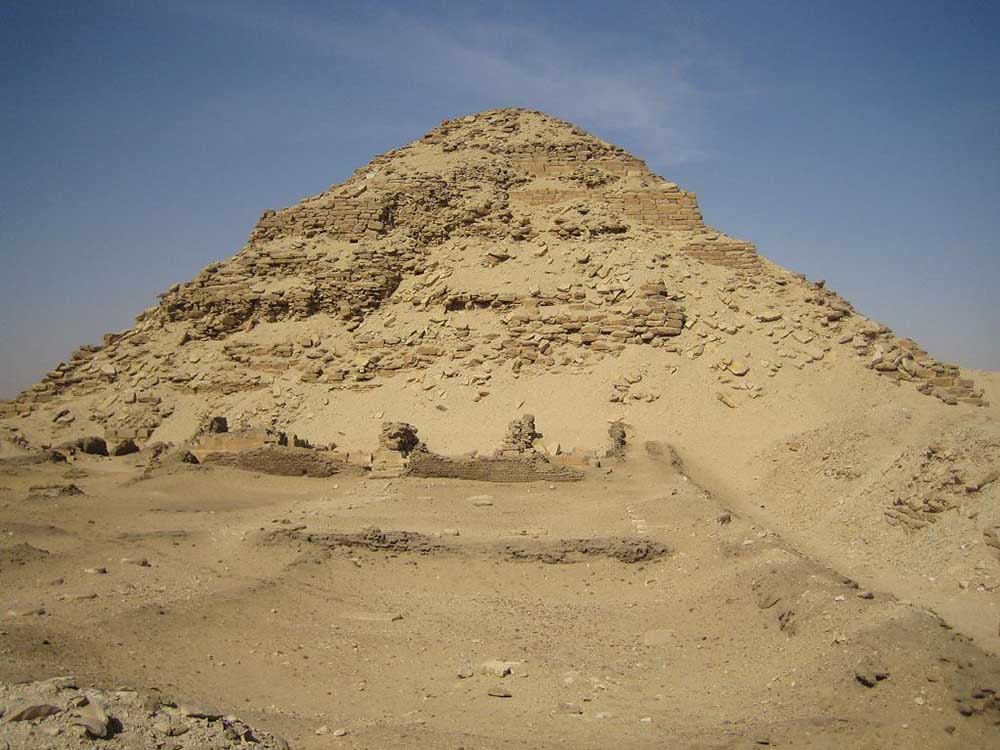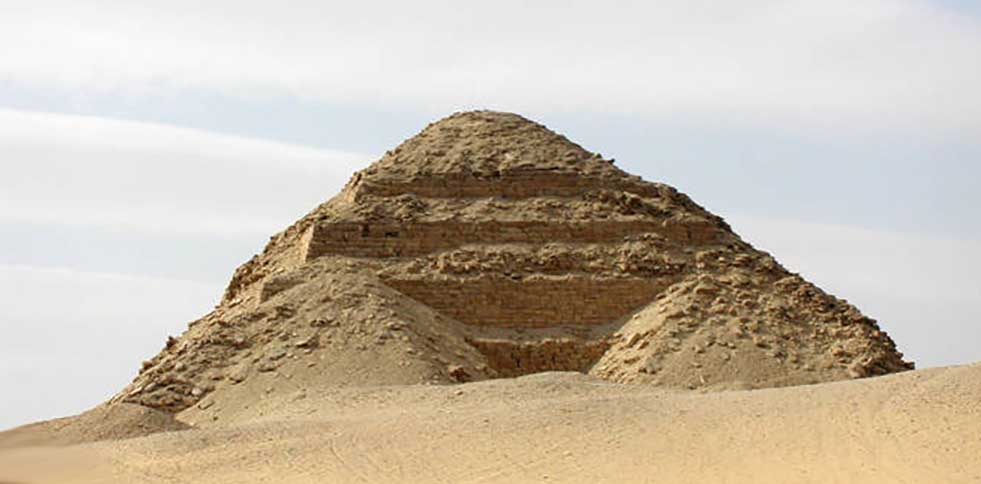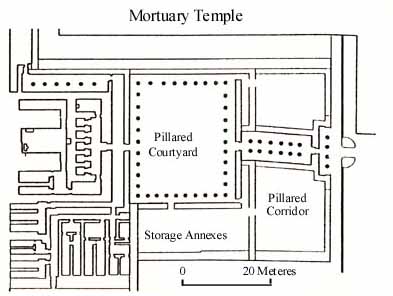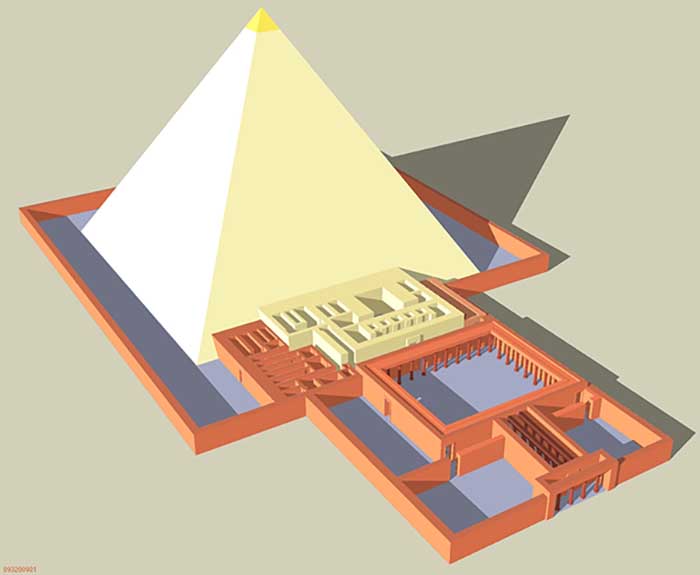
Neferirkare's pyramid with original step pyramid clearly visible underneath the rubble exterior


Neferirkare's pyramid with original step pyramid clearly visible underneath the rubble exterior

Original name: The Ba-soul of Neferirkare
Original height: 70 m / 230 ft.
Base length: 105 m / 350 ft.
Angle of inclination 53 ° 7' 48"
Date of construction: 5th dynasty
Although the pyramid looks like an ant hill, it is said to be the best conserved pyramid in Abusir. It was the second pyramid that was built there. It is the highest of them all but has never been completed. Moreover, parts of the burial site were taken in possession by Niuserre. Papyri that were found in the mortuary temple could tell us about details of administration of the temple and everyday life.

The Pyramid of Neferirkare is situated on the necropolis at Abusir, between Saqqara and the Giza Plateau. Abusir assumed great import in the Fifth Dynasty after Userkaf, the first ruler, built his sun temple and, his successor, Sahure inaugurated a royal necropolis there with his funerary monument. Sahure's successor, his son Neferirkare, was the second ruler to be entombed in the necropolis. The Egyptologist Jarom’r Krejci proposes a number of hypotheses for the position of Neferirkare's complex in relation to Sahure's complex:
(1) that Neferirkare was motivated to distance himself from Sahure and thus chose to found a new cemetery and redesign the mortuary temple plan to differentiate it from Sahure's;
(2) that geomorphological pressures Đ particularly the slope between Neferirkare's and Sahure's complexes - required Neferirkare to situate his complex elsewhere;
(3) on the basis of the site being the highest point, Neferirkare may have selected it to ensure his complex dominated the surrounding area and;
(4) that the site may have been intentionally selected to build the pyramid in line with Heliopolis.
The Abusir diagonal is a figurative line connecting the north-west corners of the pyramids of Neferirkare, Sahure and Neferefre. It is similar to the Giza axis, which connects the south-east corners of the Giza pyramids, and converges with the Abusir diagonal to a point in Heliopolis.
The location of the complex impacted the construction process. The Egyptologist Miroslav Barta states that one of the major factors influencing the location was their position in relation to the administrative capital of the Old Kingdom, Inbu-Hedj known today as Memphis.
Providing that the location of ancient Memphis is accurately known, the Abusir necropolis would have been no further than 4 km (2.5 mi) from the city centre. The benefit of the site being close to the city was the increased access to resources and manpower. South-west of Abusir, workers could exploit a limestone quarry to gather resources for the manufacture of masonry blocks used in the construction of the pyramid. The limestone there was particularly easy to quarry considering that gravel, sand and tafl layers sandwiched the limestone into thin segments of between 0.60 m (2.0 ft) and 0.80 m (2 ft 7 in) thick making it easier to dislodge from its matrix.
In 1838, John Shae Perring, an engineer working under Colonel Howard Vyse, cleared the entrances to the pyramids of Sahure, Neferirkare and Nyuserre. Five years later, the Egyptologist Karl Richard Lepsius, sponsored by King Frederick William IV of Prussia, explored the Abusir necropolis and catalogued Neferirkare's pyramid as XXI.
It was Lepsius who proposed the theory that the accretion layer method of construction was applied to the pyramids of the Fifth and Sixth Dynasty. One important development was the discovery of the Abusir papyri, found in the temple of Neferirkare during illicit excavations in 1893.
In 1902-8, the Egyptologist Ludwig Borchardt, working for the Deutsche Orient-Gesellschaft or German Oriental Society, resurveyed those same pyramids and had their adjoining temples and causeways excavated. Borchardt's was the first, and only other, major expedition carried out at the Abusir necropolis, and contributed significantly to archaeological investigation at the site. His findings were published in Das Grabdenkmal des Kšnigs Nefer-Ir-Ke-Re (1909).The Czech Institute of Egyptology has had a long-term excavation project going at the site since the 1960s.

Layout
Pyramid construction techniques underwent a transition in the Fifth Dynasty. The monumentality of the pyramids diminished, the design of mortuary temples changed, and the substructure of the pyramid became standardized. By contrast, relief decoration proliferated and the temples were enriched with greater storeroom complexes.
These two conceptual changes had developed by the time of Sahure's reign at the latest. Sahure's mortuary complex indicates that symbolic expression through decoration became favored over sheer magnitude. For example, Fourth Dynasty pharaoh Khufu's complex had a total of 100 linear metres (330 linear feet) reserved for decoration, while Sahure's temple had around 370 linear metres (1,200 linear feet) dedicated to relief decorations.
Barta identifies that storage space in mortuary temples expanded consistently from Neferirkare's reign onwards. This was a result of the combined centralization of administrative focus onto the funerary cult, the increase in the numbers of priests and officials involved in the maintenance of the cult, and the increase in their revenues.The discovery of considerable remains of stone vessels Đ mostly broken or otherwise incomplete - in the pyramid temples of Sahure, Neferirkare, and Neferefre bears testament to this development.
Old Kingdom mortuary complexes consisted of five essential components: (1) a valley temple; (2) a causeway; (3) a mortuary temple; (4) a cult pyramid; and (5) the main pyramid. Neferirkare's mortuary complex only had two of these basic elements: a mortuary temple which had been hastily constructed from cheap mudbrick and wood; and the largest main pyramid at the site.
The valley temple and causeway that were originally intended for Neferirkare's monument were co-opted by Nyuserre for his own mortuary complex. Conversely, a cult pyramid never entered construction, as a consequence of the rush to complete the monument upon Neferirkare's death. Its replacement was a small settlement and lodgings constructed from mudbrick to the south of the complex where the priests would live. An enormous brick enclosure wall was built around the perimeter of the pyramid and mortuary temple to complete Neferirkare's funerary monument.
Main Pyramid
The monument was intended as a step pyramid, an unusual choice for a Fifth Dynasty king, given that the era of step pyramids ended with the Third Dynasty (26th or 27th century BC) centuries prior, depending on the scholar and source. The reasoning behind this choice is not understood.
The Egyptologist Miroslav Verner considers a speculative connection between the Turin Canon's listing him "as the founder of a new dynasty" and the original project, though he also considers the possibility of religious reasons and power politics as well.
The first build contained six carefully laid steps of high quality stone blocks reaching a height of 52 m (171 ft; 99 cu).A white limestone casing was to be applied to the structure, but after minimal work on this was completed - extending only to the first step - the pyramid was redesigned to form a "true pyramid". Verner describes the architecture of a Fifth Dynasty pyramid thusly;
To convert the step into a genuine pyramid, the whole structure was extended outwards by about 10 m (33 ft; 19 cu) and raised a further two steps in height. This expansion project was completed in rough order with small stone fragments that were intended to be cased in red granite.
The premature death of the king halted the project after only the lowest level(s) of the casing had been completed. The resultant base of the structure measured 105 m (344 ft; 200 cu) on each side, and, had the project been completed, the pyramid would have reached approximately 72 m (236 ft; 137 cu) in height with an inclination from base to tip of about 54°. Despite the incompleteness of the structure, the pyramid - which is of comparable size to Menkaure's pyramid at Giza - dominates over its surrounds as a result of the position of its site standing on a hill some 33 m (108 ft) above the Nile delta.
Substructure
The descending corridor near the middle of the north face of the pyramid serves as the entry into the substructure of Neferirkare's pyramid. The corridor begins approximately 2 m (6 ft 7 in) above ground level and ends at a similar depth below ground level. It has proportions of 1.87 m (6 ft 2 in) height and 1.27 m (4 ft 2 in) width.
It is reinforced at the entrance and exit points with granite casing. The corridor breaks out into a vestibule leading to a longer corridor that is guarded by a portcullis. This second corridor has two turns, but maintains a generally eastward direction and ends in an antechamber that is offset from the burial chamber. The roof of the corridor is unique: the flat roof has a second gabled roof made of limestone on top of it which itself has a third roof made from a layer of reeds.
The burial and ante chamber's ceilings were constructed with three gabled layers of limestone. The beams disperse weight from the superstructure onto either side of the passageway, preventing collapse. Thieves have ransacked the chambers of its limestone making it impossible to properly reconstruct, though some details can still be discerned. Namely, that (1) both rooms were oriented along an east-west axis, (2) both chambers were the same width; the antechamber was shorter of the two, and (3) both chambers had the same style roof, and are missing one layer of limestone.]
Overall, the substructure is badly damaged: the collapse of a layer of the limestone beams has covered the burial chamber. No trace of the mummy, sarcophagus, or any burial equipment has been found inside. The severity of the damage to the substructure prevents further excavation.
Mortuary Temple
The mortuary temple is located at the base of the pyramid's Eastern face. It is larger than is typical for the period. Archaeological evidence suggests that it was unfinished at Neferirkare's death, and was completed by Neferefre and Nyuserre. For example, while the inner temple and statue niches were built from stone, much of the rest of the temple, including the court and entrance hall, was apparently hastily completed using cheap mudbrick and wood. This left large portions of the mortuary temple susceptible to erosion from rain and wind, where stone would have given it significant durability. The site was less aesthetically impressive, although its basic layout and features remained roughly analogous to Sahure's temple. Its enlarged size can be attributed to a design decision to build the complex without a valley temple or a causeway. Instead, the causeway and temple, whose foundations had been constructed, were diverted to Nyuserre's complex
The temple was entered through the columned portico, and columned entrance hall which terminates into a large columned courtyard.The columns of the hall and courtyard are made from wood arranged into the form of lotus stalks and buds.The courtyard is adorned with thirty-seven such columns; these columns are asymmetrically positioned.
The archaeologist Herbert Ricke hypothesized that columns near the altar may have been damaged by fire and removed. A papyrus fragment from the temple archives corroborates this story. A low stepped ramp in the courtyard's west leads to a transverse (north-south) corridor which leads south into storerooms and north into another smaller corridor containing six wooden columns through which the open courtyard of the main pyramid can be accessed. It is in the southern storerooms that the Abusir papyri were discovered by grave robbers in the 1890s.Beyond the storerooms is a gate which has another access point to the main pyramid's courtyard, and through which a second excavated south-western gate leads to Khentkaus II's complex.Finally, traversing across the corridor leads directly into the inner sanctuary or temple
The surviving reliefs are fragmentary. Of the preserved materials, one particular block stands out as vitally important in reconstructing the genealogy of the royal family at this time. A limestone block, discovered in the 1930s by Egyptologist Edouard Ghazouli, depicts Neferirkare with his consort, Khentkaus II, and eldest son, Neferefre. It was not found at the site of the pyramid, but as a part of a house in the village of Abusir.
The Abusir papyri document details concerning Neferirkare's mortuary temple at Abusir. One testimony from the papyri is that five statues were housed in the niches of the central chapel. The central statue depicted Neferirkare as the deity Osiris, whereas the two outermost statues portrayed him as the king of Upper and Lower Egypt respectively. The papyri also record the existence of at least four funerary boats at Abusir. Two boats are located in sealed rooms while the other two are to the north and south of the pyramid itself. The southern boat was discovered when Verner unearthed the funerary boat during excavations.
Valley Temple, Causeway and Cult Pyramid
At the time of Neferirkare's death, only the foundations of the valley temple and two-thirds of the causeway to the mortuary temple had been laid. When Nyuserre took over the site, he had the causeway diverted from its original destination to his own mortuary temple. As such, the causeway travels in one direction for more than half its distance, then bends away to another for the remainder of its length.
The purpose of the cult pyramid remains unclear. It had a burial chamber but was not used for burials, and instead appears to have been a purely symbolic structure. It may have hosted the pharaoh's ka (spirit), or a miniature statue of the king. It may have been used for ritual performances centering around the burial and resurrection of the ka spirit during the Sed festival. Neferirkare's monument has no cult pyramid. Rather, the cult pyramid was replaced with a small settlement, called Ba Kakai,] of mudbrick lodgings for priests, south of the monument.
The omission of these "essential" elements has had one significant impact. Under normal circumstances, the priests tending to the deceased pharaoh's funerary cult would have lived in a 'pyramid town' built in the vicinity of the valley temple, situated on the Abusir Lake. The daily records of the administration would have had their residence in the town with the priests. Instead, as a result of circumstance, these documents were instead kept inside the mortuary temple. This has allowed their archives to be preserved, as they would have otherwise long ago disintegrated, buried under the mud.The siting of the settlement by the complex also allowed small restorative works to be conducted.
Later History
Nyuserre was the last king to build his funerary monument at Abusir; his successors Menkauhor and Djedkare Isesi chose sites elsewhere. Abusir thus ceased to be the royal necropolis. This did not mean that the site had been abandoned. The records of the Abusir Papyri demonstrate that funerary cults remained active at Abusir at least until the reign of Pepi II at the end of the Sixth Dynasty.
Verner believes that royal cultic activities ceased by the First Intermediate Period. Malek, notes that some limited evidence for the persistence of the cults of Neferirkare and Nyuserre throughout the Herakleopolitan Period exists, though this means that Nyuserre's cult operated continuously until at least the Twelfth Dynasty.
Professor Antonio Morales believes that funerary cults may have continued beyond the Old Kingdom, in particular the cult of Nyuserre appears to have survived both in its official form and in popular public veneration until the early Middle Kingdom, and some scant evidence in the form of two statues dated to the Middle Kingdom may suggest that Neferirkare's cult was active during that period as well.
The necropolae near Memphis, specifically those at Saqqara and Abusir, were used extensively during the Twenty-Sixth Dynasty (ca. 664-525 BC). Considerable quantities of stone were required to build these tombs, and this was very probably sourced from the Old Kingdom pyramids, thereby inflicting further damage to them. Graves estimated to be from the fifth century BC have been discovered in the vicinity of Neferirkare's mortuary temple. One yellow calcite gravestone, discovered by Borchardt, bears an Aramaic inscription: (Belonging) to NSNW the daughter of Pahnum.